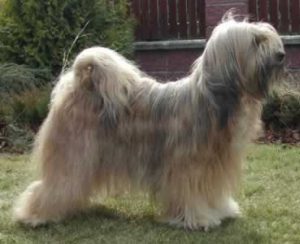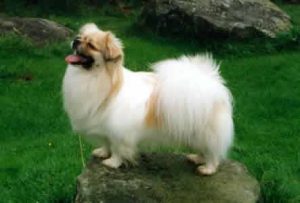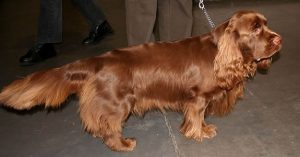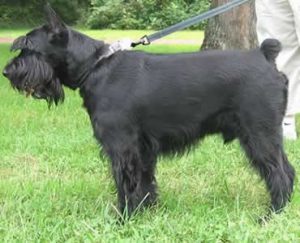
The Tibetan Terrier is not a member of the terrier group, the name being given to it by European travellers to Tibet who were reminded of terriers from back home when they first encountered the breed. Its origins are uncertain: Some sources claim them to be lucky temple dogs, whereas others place them as farm dogs.
The Tibetan Terrier is a dog with many uses, able to guard, herd, and also be a suitable companion dog. Their utility in Tibet meant that the first examples of the breed available in the west were generally given as gifts, as the Tibetan Terrier, along with other Tibetan breeds, were too valuable to the people who owned them to casually sell. As such, the early history of the breed is linked to only a handful of foundation dogs.
The Tibetan name for the breed, Tsang Apso, roughly translates to “shaggy or bearded (apso) dog, from the province of Tsang”. Some old travellers’ accounts give the name “Dokhi Apso,” or “outdoor” Apso, indicating a working dog which lives outdoors. Other “Apso” dogs from Tibet include the smaller and more familiar Lhasa Apso (called the Lhasa Terrier in the early 1900s) and the very rare Do Khyi Apso (bearded Tibetan Mastiff, sometimes considered as a TT/TM cross.)
Recent DNA analysis has concluded that the Tibetan Terrier is descended from the most ancient dog breeds.
Appearance
The appearance of the Tibetan Terrier is that of a powerful, medium sized dog of square proportions, with a shaggy coat. Overall, there should be a feel of balance. Fully grown, he or she should look like a miniaturised Old English Sheepdog.
The head is moderate, with a strong muzzle of medium length, and a skull neither rounded nor flat. The eyes are large, dark, and set fairly far apart. The V-shaped drop ears are well feathered, and should be set high on the sides of the skull. The nose is always black, regardless of coat colour.
The body is well muscled and compact. The length of the back should be equal to the height at the withers, giving the breed its typical square look. Height for either sex is 14-16 in (35-41 cm) and weight is 18-30 lb (8–14 kg), with 20-24 lb (9.5–11 kg) preferred, but all weights acceptable if in proportion to the size.
The tail is set high, well feathered, and carried in a curl over the back.
One of the more unusual features of the Tibetan Terrier is the broad, flat feet with hair between the toes. They are ideal for climbing mountains and act as natural snow shoes.
Coat
Tibetans have hair, not fur; as a result, their coat grows continuously and pet animals will require occasional trimming. They do not shed but rather slough hair at a rate similar to that of most humans. The exception is at approximately nine months when puppies slough their entire coat in advance of acquiring their adult coat. The double coat is profuse, with a warm undercoat and a topcoat which has the texture of human hair. It should not be silky or curled, but wavy is acceptable. Long and thick, it is shown natural, but should not be so long as to touch the floor, as is typical in breeds such as the Lhasa Apso or Maltese. A fall of hair covers the face and eyes, but long eyelashes generally prevent hair from getting in the Tibetan Terrier’s eyes, and the breed has very good eyesight.
Colour
All colours are permissible, barring liver and chocolate, and none are preferred. Tibetan Terriers are available in any combination of solid, particolour, tricolour, brindle or piebald, as long as the nose leather is black and the eyes and eye rims are dark.
Temperament
The temperament has been one of the most attractive aspects of the breed since it was first established. They are amiable and affectionate family dogs, sensitive to their owners and gentle with older children. As is fitting a dog formerly used as a watch dog, they tend to be reserved around strangers, but should never be aggressive nor shy with them.
Suitable for apartment living, the Tibetan is still an energetic and surprisingly strong dog, and needs regular exercise. Their energy level and intelligence is well suited for dog sports such as agility. They are steadfast, determined, and clever, which can lead to them being stubborn. Some dogs of this breed can often be jealous, which can make it hard to live with another pet.
Though not yappy, the Tibetan Terrier has an assertive bark, likened to a rising siren.
Energy Level: moderate to high General Nature: happy, active, lively, intelligent, agile
With Children: good if properly introduced, supervised with well behaved children
With other pets: generally good
With dogs: generally good
Socialisation requirements: required to help address inclination to shyness to strangers
Ideal home characteristics: one devoted to regular grooming and care of the coat in addition to other needs
Temperament Notes: charming and loyal, sensitive and intelligent
Training requirement: dependent entirely on goals
Intelligent and sensitive nature. Training kept interesting and positive will move quickly. This is not a dog that will benefit from force of any form.
—————————————————————————————————————–
CARING FOR YOUR DOG NEWSLETTER – Delivered Directly To Your Inbox – Starting Immediately – SIGN UP FOR FREE TODAY
—————————————————————————————————————–




